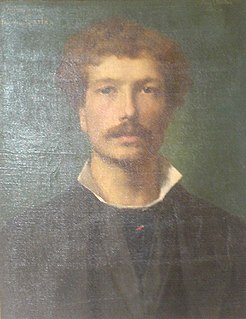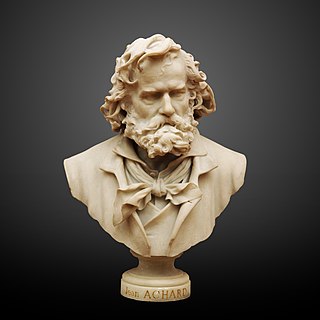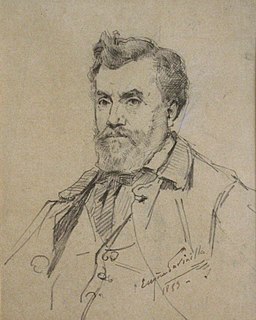
Charles Olivier de Penne (Paris, January 11, 1831 - Bourron-Marlotte, April 18, 1897) was a French painter. He belonged to the School of Barbizon.

Charles Olivier de Penne (Paris, January 11, 1831 - Bourron-Marlotte, April 18, 1897) was a French painter. He belonged to the School of Barbizon.
Charles-Olivier de Penne was initially a painter of historical scenes, but, as soon as he came into contact with the school of Barbizon, [1] he switched to landscape painting, in which he poured his passion for animals. He became famous for his paintings of hunting scenes or landscapes with animals.
He attempted the grand Prix de Rome in 1857, but only got the second prize with the work Jésus et la Samaritaine. [2] He then exhibited regularly at both the Paris Salon and the Salon des Artistes Français, where he won a bronze medal in 1872 and a silver medal in 1883. Another silver medal was awarded to him at the 1889 Expo.

The Barbizon school of painters were part of an art movement towards Realism in art, which arose in the context of the dominant Romantic Movement of the time. The Barbizon school was active roughly from 1830 through 1870. It takes its name from the village of Barbizon, France, on the edge of the Forest of Fontainebleau, where many of the artists gathered. Most of their works were landscape painting, but several of them also painted landscapes with farmworkers, and genre scenes of village life. Some of the most prominent features of this school are its tonal qualities, color, loose brushwork, and softness of form.
The grand prix de l'Imaginaire, until 1992 the grand prix de la science-fiction française, is a French literary award for speculative fiction, established in 1972 by the writer Jean-Pierre Fontana as part of the science fiction convention of Clermont-Ferrand.

Girolamo Graziani, was an Italian poet.

Léon Germain Pelouse was a self-taught French painter born in Pierrelaye. At sixteen, he began working as a traveling salesman. He began painting when he was twenty, as he was serving in the French army as a conscript. His professional painting career began at twenty-seven, with the exhibition of his Les Environs de Précy at the Salon de Paris of 1865. Despite severe criticism, he continued painting. He moved to Brittany, and there, inspired by nature around Pont-Aven and Rochefort-en-Terre, Pelouse painted landscapes which were exhibited at the Salon de Paris in the following years. He received his first medal in 1873 for Vallée de Cernay. He finally gained success and critical approval. The French government bought many of his works which are now in the holdings of museums including the Musée d'Orsay, the Musée Malraux, and the Musée des Beaux-Arts de Nantes.

Fleury François Richard, sometimes called Fleury-Richard, was a painter of the École de Lyon. A student of Jacques-Louis David, Fleury-Richard and his friend Pierre Révoil were precursors of the Troubador style.

Jean-Antonin Carles was a French sculptor.

Jean Alexis Achard (1807–1884) was a French painter.

Eugène Lavieille was a French painter.

Agostino Paravicini Bagliani is an Italian historian, specializing in the history of the papacy, cultural anthropology, and in the history of the body and the relationship between nature and society during the Middle Ages.
Artmedia was one of the first scientific projects concerning the relationship between art, technology, philosophy and aesthetics. It was founded in 1985 at the University of Salerno. For over two decades, until 2009, dozens of projects, studies, exhibitions and conferences on new technologies made Artmedia a reference point for many internationally renowned scholars and artists, and contributed to the growing cultural interest in the aesthetics of media, the aesthetics of networks, and their ethical and anthropological implications.
Giovanni Battista Valentini, (Cantalicio), was an Italian humanist, author and Catholic bishop.
Alessandro Vezzosi is an Italian art critic, Leonardo scholar, artist, expert on interdisciplinary studies and creative museology, he is also the author of hundreds of exhibits, publications and conferences, in Italy and abroad on Leonardo da Vinci and the Renaissance, contemporary art and design. Amongst others, he was the first scholar from the Armand Hammer Centre for Leonardo Studies from the University of California in Los Angeles (1981), directed by Carlo Pedretti; he taught at the University of Progetto in Reggio Emilia; and he is honorary professor at the Accademia delle Arti del Disegno of Florence. He began as an artist from 1964 to 1971 winning more than 80 prizes in painting competitions. In the Seventies he was the founder of the “Archivio Leonardisimi” and of Strumenti-Memoria del Territorio; he coordinated "ArteCronaca", he was the historical-artistic consultant of the Municipality of Vinci and he collaborated on the publications on Tuscany and Leonardo, modern and contemporary art. In 1980 he curated the Centro di Documentazione Arti Visive of the Municipality of Florence.

Alberto Toscano is an Italian journalist, writer and political scientist living in France since 1986 and working with several Italian and French media.

Albert Lebourg, birth name Albert-Marie Lebourg, also called Albert-Charles Lebourg and Charles Albert Lebourg, was a French Impressionist and Post-Impressionist landscape painter of the Rouen School. Member of the Société des Artistes Français, he actively worked in a luminous Impressionist style, creating more than 2,000 landscapes during his lifetime. The artist was represented by Galerie Mancini in Paris in 1896, in 1899 and 1910 by : Galerie Bernheim-Jeune, 1903 and 1906 at the Galerie Paul Rosenberg, and 1918 and 1923 at Galerie Georges Petit.
Giulia Bogliolo Bruna is an Italian ethno-historian, living in France, specialist of the discovery travels at the Renaissance, of the Imaginary of the North and of the Inuit in Frencophone and Anglophone travel literature, and of the Inuit people, culture and traditional art

Sylvie Mamy, born in Besançon, is a French writer and musicologist, Docteur d'État ès lettres, and research director at the CNRS.

Nanine Vallain (1767–1815) was a French painter active between 1785 and 1810. She was sometimes known as Jeanne-Louise Vallain or Madame Piètre.

Ruffo di Calabria is one of the longest-standing noble families in Italy. It was already one of the seven most important houses of the Kingdom of Naples; their notable members include Rembrandt's patron Antonio Ruffo, the flying ace Fulco Ruffo di Calabria and his daughter Paola Ruffo di Calabria, queen-consort of Albert II of Belgium.

Laurent Guétal, also known as the Abbé Guétal was a French landscape painter and Catholic priest.
Cristiano Leone is an Italian philologist, known for his roles as curator, artistic director and playwright. Currently he teaches at Sciences Po in Paris and the Università Bocconi in Milan.